Iron oxide
Class of chemical compounds composed of iron and oxygen From Wikipedia, the free encyclopedia
An iron oxide is a chemical compound composed of iron and oxygen. Several iron oxides are recognized. Often they are non-stoichiometric. Ferric oxyhydroxides are a related class of compounds, perhaps the best known of which is rust.[1]

Iron oxides and oxyhydroxides are widespread in nature and play an important role in many geological and biological processes. They are used as iron ores, pigments, catalysts, and in thermite, and occur in hemoglobin. Iron oxides are inexpensive and durable pigments in paints, coatings and colored concretes. Colors commonly available are in the "earthy" end of the yellow/orange/red/brown/black range. When used as a food coloring, it has E number E172.
Stoichiometries


Iron oxides feature as ferrous (Fe(II)) or ferric (Fe(III)) or both. They adopt octahedral or tetrahedral coordination geometry. Only a few oxides are significant at the earth's surface, particularly wüstite, magnetite, and hematite.
- Oxides of FeII
- FeO: iron(II) oxide, wüstite
- Mixed oxides of FeII and FeIII
- Oxides of FeIII
- Fe2O3: iron(III) oxide
- α-Fe2O3: alpha phase, hematite
- β-Fe2O3: beta phase
- γ-Fe2O3: gamma phase, maghemite
- ε-Fe2O3: epsilon phase
- Fe2O3: iron(III) oxide
Thermal expansion
Oxide-hydroxides
- goethite (α-FeOOH)
- akaganéite (β-FeOOH)
- lepidocrocite (γ-FeOOH)
- feroxyhyte (δ-FeOOH)
- ferrihydrite (Fe5HO8 · 4 H2O approx., or 5 Fe2O3 · 9 H2O, better recast as FeOOH · 0.4 H2O)
- high-pressure pyrite-structured FeOOH.[7] Once dehydration is triggered, this phase may form FeO2Hx (0 < x < 1).[8]
- green rust (FeIII
xFeII
yOH3x + y − z (A−)z where A− is Cl− or 0.5 SO2−4)
Reactions
In blast furnaces and related factories, iron oxides are converted to the metal. Typical reducing agents are various forms of carbon. A representative reaction starts with ferric oxide:[9]
- 2 Fe2O3 + 3 C → 4 Fe + 3 CO2
In nature
Iron is stored in many organisms in the form of ferritin, which is a ferrous oxide encased in a solubilizing protein sheath.[10]
Species of bacteria, including Shewanella oneidensis, Geobacter sulfurreducens and Geobacter metallireducens, use iron oxides as terminal electron acceptors.[11]
Uses
Almost all iron ores are oxides, so in that sense these materials are important precursors to iron metal and its many alloys.
Iron oxides are important pigments, coming in a variety of colors (black, red, yellow). Among their many advantages, they are inexpensive, strongly colored, and nontoxic.[12]
Magnetite is a component of magnetic recording tapes.
See also
References
External links
Wikiwand - on
Seamless Wikipedia browsing. On steroids.
